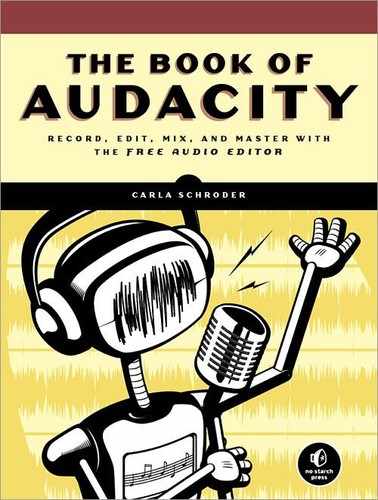DVD-Audio is a digital audio format for DVDs. It is not the same, as the audio formats used in DVD movies but is a different format just for audio. DVD movies use various compressed, lossy audio formats to preserve disk space, which even on a DVD is at a premium when you combine movie-length video and multichannel surround sound. DVD-Audio supports professional studio master audio quality, which is 24/192. If you’re content with CD audio (16/44.1 stereo), you can cram about seven hours’ worth onto a single standard 4.7GB DVD. At 24/192, you’ll get about 75 minutes of music on a standard DVD. Some DVD-authoring software supports writing to 8.5GB double-layer DVDs, so you can really pile in the tunes. The DVD-Audio standard also supports still pictures and video menus.
Note
Sometimes home-burned double-layer DVDs are not reliable on different playback devices. Stick with the good-quality brands of DVD blanks and make sure that your DVD player supports both double-layer DVD-R and DVD-Audio. Your particular DVD writer may work better with specific brands of blanks, so use what your manufacturer recommends.
DVD-Audio is an LPCM format like WAV and AIFF. It supports bit depths of 16, 20, and 24 and sampling rates up to 192 kHz. Audacity supports 16- and 24-bit depths and pretty much any sampling rate you want. If the rate you want isn’t in the Edit > Preferences > Quality dialog, just enter your own in Edit > Preferences > Quality > Default Sample Rate > Other.
DVD-Audio has a theoretical dynamic range of 144 dB, though the limitations of audio hardware mean your maximum dynamic range is always about 120 dB. Dynamic range in this context isn’t about cranking the volume or blasting your listeners with sudden extreme peaks; the advantages of an extremely wide dynamic range are loads of headroom for recording and processing and a very low noise floor.
DVD-Audio supports a range of stereo and surround channel combinations at 24 bits: 1.0 mono and 2.0 stereo at sampling rates of 44.1 kHz, 48 kHz, 88.2 kHz, 96 kHz, 176.4 kHz, and 192 kHz.
These all support sampling rates of 44.1 kHz, 48 kHz, 88.2 kHz, and 96 kHz at 24 bits:
2.1 stereo (left, right, LFE)
3.0 (left, right, surround)
3.1 (left, right, surround, LFE)
4.0 (left, right, center, surround)
4.1 (left, right, center, surround, LFE)
5.0 (left, right, center, surround right, surround left)
5.1 (left, right, center, surround right, surround left, LFE)
The low-frequency effects (LFE) channel deserves a bit of explanation. It’s often assumed to be the subwoofer channel, but this is not quite right. The LFE channel is a special channel that carries sounds in the 3 Hz to 200 Hz frequency range, and the LFE signal can be sent to any speaker capable of handling this range.
Uncompressed DVD-Audio has a bitrate limit of 9.6Mbps, so you can have glorious 24/192 two-channel stereo. But you’re not going to get uncompressed 5.1 surround at full 24/192 resolution because 9.6Mbps is not enough bandwidth for full resolution on all of those channels. The best you’ll get is 24/96 in 5.1. You can have different resolutions on different channels, such as 24/96 for the two front channels and 16/48 on the surround channels. You need compression to get higher resolution for 5.1, and the only compression supported by the DVD-Audio standard is the proprietary Meridian Lossless Packing (MLP) lossless compression. A license for MLP is expensive, usually more than $2,000, and available only for Windows and Mac authoring software.
